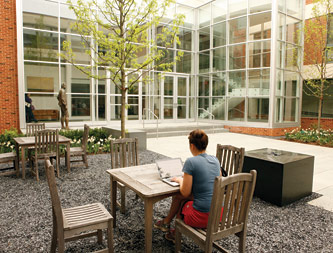This year marks the 20th anniversary of the completion of construction on the David A. Harrison III Law Grounds project, which involved the creation of Caplin Pavilion, Spies Garden, Holcombe T. Green Lawn, Hunton & Williams Hall, and Clay Hall, the front façade of the Law School that connects Withers-Brown and Slaughter halls.
Joining the 1970s homes of Darden and the Law School wasn’t easy. Philip Mills Herrington, a graduate of UVA’s doctoral program in history and author of a new book on the Law School’s buildings, said the two existing structures, which faced each other but not Massie Road, created “a really interesting design problem.”
“You want a building that tells the world that this is a nationally important law school, and you want something that revisits the history of the University and the Law School in a much more pronounced way than the 1970s buildings did,” Herrington said. “I think the architects did a fantastic job of solving that problem. I think overall the Law School finally felt it had a building that matched its sense of self as an institution. That was something it hadn’t had since it left Clark Hall.”
Founded in 1819, the University of Virginia School of Law is the second-oldest continuously operating law school in the nation. Consistently ranked among the top law schools, Virginia is a world-renowned training ground for distinguished lawyers and public servants, instilling in them a commitment to leadership, integrity and community service.
 Karsh Student Services Center Awarded for Outstanding Design
Karsh Student Services Center Awarded for Outstanding Design


